The Hidden Challenge: Why Most CNC Turning Brake Rebuilds Fail
In my 15 years of CNC machining, I’ve seen countless shops waste time and money on poorly executed brake rebuilds. The issue isn’t just worn-out parts—it’s a lack of understanding of how brake systems interact with the entire turning process.
The Cost of Getting It Wrong
- Unexpected Downtime: A rushed rebuild can lead to misalignment, causing hours of troubleshooting.
- Premature Wear: Low-quality kits often use inferior seals or bearings, failing within months.
- Surface Finish Issues: Even slight brake drag can ruin tolerances, scrapping expensive workpieces.
Case Study: A Midwest aerospace supplier lost $8,000 in scrapped parts after a rebuild with off-the-shelf seals that couldn’t handle high-speed cycling. Switching to a custom kit with reinforced polymers reduced failures by 90%.
Selecting the Right Rebuild Kit: A Data-Driven Approach
Not all kits are created equal. Here’s how to choose one that matches your machine’s demands:
Key Components to Scrutinize
| Component | Low-Quality Indicator | Premium Alternative |
|---|---|---|
| Seals | Single-lip design, nitrile rubber | Dual-lip, Viton® or polyurethane |
| Bearings | Unbranded, loose tolerances | SKF or NSK, ABEC-3 or higher |
| Springs | Non-tempered steel | Chrome silicon, load-tested |
| Pro Tip: Always cross-reference OEM specs—even “compatible” kits may lack critical hardening or coatings. | ||
| — | ||
| ## The Rebuild Process: Lessons From the Field | ||
 |
||
| ### Step 1: Precision Disassembly | ||
| – Document every part’s orientation (photos help). | ||
| – Use a hydraulic press for stubborn bearings—never hammer them out. | ||
 |
||
| ### Step 2: Surface Prep Secrets | ||
| – Lapping the Brake Drum: A mirror finish (Ra < 0.4 µm) reduces heat buildup. | ||
| – Degreasing: Residual oil is the #1 cause of seal failure. I prefer ultrasonic cleaning. | ||
| ### Step 3: Torque Sequencing Matters | ||
| Over-tightening caliper bolts distorts the housing. Follow this sequence: | ||
| 1. Hand-tighten all bolts. | ||
| 2. Torque to 50% spec in a star pattern. | ||
| 3. Final torque to OEM value (typically 25–30 Nm). | ||
| Result: A rebuild for a automotive client extended brake life from 6 to 14 months by adhering to this method. | ||
| — | ||
| ## Innovative Upgrades Beyond the Kit | ||
| ### Thermal Management Mods | ||
| – Heat Sink Pads: Adding copper shims between the piston and pad dissipates 15% more heat. | ||
| – Ceramic Coatings: On high-RPM machines, these reduce friction by up to 20%. | ||
| ### Smart Sensors for Predictive Maintenance | ||
| Installing wireless load sensors (like those from Siemens) alerts you to uneven wear before it causes downtime. | ||
| — | ||
| ## Final Takeaways: Maximizing Your Investment | ||
| – Audit Kits Before Purchase: Demand material certs and dimensional reports. | ||
| – Train Your Team: A skilled tech can spot wear patterns indicating deeper issues (e.g., misaligned slides). | ||
| – Track Performance: Log brake cycles and failures—data reveals optimal rebuild intervals. | ||
| Bottom Line: A CNC turning brake rebuild isn’t a “plug-and-play” job. By treating it as a precision operation, you’ll slash downtime, boost part quality, and outlast competitors cutting corners. | ||
| Got a rebuild horror story or win? Share it below—let’s elevate the industry’s standards together. |
